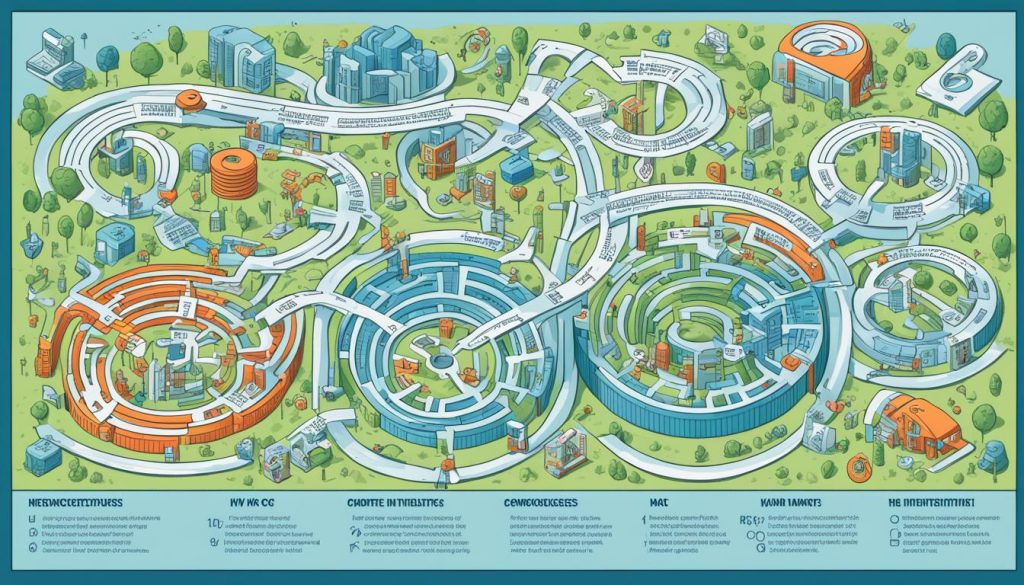Mastering accurate cost estimation can boost your HVAC contractor’s profitability. This skill helps you balance your pricing strategy. It ensures you meet customer needs and reach your financial goals. By using precise HVAC project cost management, you’ll stand out in the market.
Accurate construction cost estimation is key to a successful HVAC business. It lets you use resources wisely, adapt to market changes, and keep customers happy. By adjusting your pricing, you’ll make more profits and stay ahead in the HVAC industry.
To be good at HVAC cost estimation, think about labor costs, material expenses, and overhead. By understanding these, you can offer competitive bids that draw in clients and keep your business profitable. Remember, accurate estimation is about winning projects and setting up for long-term success in HVAC.
Understanding the Importance of Accurate HVAC Cost Estimation
Getting your HVAC cost estimates right is crucial for your success. It impacts your bidding, customer relationships, and growth. Let’s see why accurate estimates are so important.
Impact on Business Profitability
Accurate cost estimation is key to making a profit in the HVAC business. When you set the right prices, you cover costs and make a fair profit. This keeps your business strong and competitive.
Underestimating costs can lead to losses. Overestimating might scare off customers. So, it’s all about finding that sweet spot.
Role in Customer Satisfaction
When you give accurate estimates, customers trust you more. If the final bill matches the quote, they feel valued. This leads to more business and a good reputation.
Influence on Long-term Growth
Being consistent with accurate estimates helps your business grow. It lets you plan better, manage money well, and make smart choices about growing your business. Mastering cost estimation is key to expanding your HVAC business.
| Aspect | Impact of Accurate Estimation |
|---|---|
| Profitability | Ensures costs are covered and margins are met |
| Customer Satisfaction | Builds trust and encourages loyalty |
| Long-term Growth | Supports resource planning and informed decision-making |
Your success in bidding and pricing depends on accurate cost estimation. It’s not just about winning jobs. It’s about making sure each job helps your business grow. By focusing on precise estimates, you’re investing in your future.
Key Components of HVAC Cost Estimation
Getting accurate HVAC cost estimates is key to your business doing well. Knowing the main parts helps you make more money and plan better. Let’s look at the main parts of HVAC cost estimation.
- Labor costs
- Material expenses
- Overhead allocation
Labor costs are a big part of what you spend on HVAC projects. Keep track of how much time each task takes. This includes putting in new systems, keeping them running, and fixing them. Using job costing software can help you keep an eye on labor costs.
Material costs are for things like equipment, parts, and supplies needed for HVAC work. Keep your inventory in check to avoid too much stock or running out. Tools for tracking costs can help you manage your material expenses well.
Overhead allocation is for indirect costs like office rent, utilities, and admin stuff. Spread these costs out over your projects so each job helps pay for them.
| Component | Description | Importance |
|---|---|---|
| Labor Costs | Time spent on installation, maintenance, and repairs | High |
| Material Expenses | Equipment, parts, and supplies for projects | High |
| Overhead Allocation | Indirect costs like rent, utilities, and admin expenses | Medium |
By focusing on these main parts and using job costing software and cost tracking tools, you can make more accurate estimates. This means you’ll make more money and have better financial plans for your HVAC business.
The Role of Market Research in HVAC Pricing
Market research is key to setting the right HVAC prices. By looking closely at the market, you can find ways to make more money and stand out from others.
Analyzing Competitor Pricing
It’s important to know what your competitors charge for their services. Start by checking out local HVAC companies and their prices. This lets you set your prices right, staying competitive and profitable.
| Service | Your Company | Competitor A | Competitor B |
|---|---|---|---|
| AC Installation | $3,500 | $3,800 | $3,200 |
| Furnace Repair | $250 | $275 | $225 |
| Annual Maintenance | $150 | $175 | $140 |
Understanding Customer Expectations
Use surveys and feedback to see what customers want from HVAC services. This helps you offer what they expect, which can make them happier and more loyal.
Identifying Industry Trends
Keep up with the latest in the HVAC world through trade magazines, conferences, and reports. This info lets you predict changes in demand, technology, and prices. You can then adjust your pricing strategy ahead of time.
Adding these market research parts to your pricing strategy helps you make smart choices. This leads to more profit and growth. Always keep an eye on the market to make sure your prices stay competitive and meet customer and industry needs.
Calculating Labor Costs Accurately
Getting labor costs right is key to managing HVAC project costs well. Knowing how to estimate labor expenses correctly can greatly affect your profits. Let’s look at the main points to consider when figuring out labor costs for HVAC projects.
When figuring out labor costs, think about these important things:
- Hourly wages or salaries
- Employee benefits
- Payroll taxes
- Workers’ compensation insurance
- Training and certification expenses
By including these factors, you’ll understand your true labor costs better. This helps avoid underpricing and losses on HVAC projects.
To make calculating labor costs easier, think about using specialized HVAC estimation software. These tools help you track time, manage resources, and get accurate labor cost estimates.
| Labor Cost Component | Percentage of Total Labor Cost |
|---|---|
| Base Wages/Salaries | 60-70% |
| Employee Benefits | 15-20% |
| Payroll Taxes | 7-10% |
| Insurance | 5-8% |
| Training/Certification | 2-5% |
Remember, getting labor costs right is not just about pricing your project. It’s a key part of managing HVAC projects over time. By getting good at this, you can set competitive prices, keep healthy profit margins, and help your HVAC business grow.
Optimizing Material Cost Estimation
For HVAC businesses, knowing the cost of materials is key to making money. By managing your inventory well, negotiating with suppliers, and cutting down on waste, you can lower your costs. This helps you make more money.
Tracking Inventory Efficiently
Keeping an eye on your inventory is vital for controlling costs. Use digital systems to track what you have in real-time. This helps avoid having too much or too little stock, which can cause delays and upset customers.
- Use barcode scanners for quick item check-in/out
- Set up automatic reorder points for frequently used items
- Conduct regular physical inventory counts to reconcile digital records
Negotiating with Suppliers
Good relationships with suppliers can get you better prices and terms. Here are some tips for negotiating well:
- Bundle purchases to qualify for volume discounts
- Explore long-term contracts for price stability
- Compare quotes from multiple suppliers to leverage competitive pricing
Minimizing Waste and Overstock
It’s important to reduce waste and avoid having too much stock. Here’s how to do it:
- Use just-in-time ordering for project-specific materials
- Train staff on proper material handling and storage techniques
- Analyze usage patterns to identify slow-moving inventory
| Cost Optimization Strategy | Potential Savings | Implementation Difficulty |
|---|---|---|
| Digital Inventory Tracking | 10-15% | Medium |
| Supplier Negotiation | 5-10% | Low |
| Waste Reduction | 3-7% | High |
By focusing on these areas, you can greatly improve your HVAC business’s profits and efficiency.
Allocating Overhead Costs Effectively
For HVAC businesses, managing overhead costs is key to staying profitable. It’s important to spread out business expenses fairly. This way, your pricing can truly reflect the costs of running your business.

Overhead costs are all the expenses that don’t directly tie to a project but are still needed for the business. These include:
- Rent for office space
- Utilities
- Office supplies
- Marketing expenses
- Vehicle maintenance
- Equipment depreciation
To handle these costs well, think about a percentage-based system. First, add up all the overhead expenses. Then, divide that by the total direct costs or labor hours. This gives you a percentage to add to each project.
| Expense Category | Monthly Cost | Percentage of Total |
|---|---|---|
| Rent | $2,000 | 25% |
| Utilities | $500 | 6.25% |
| Office Supplies | $300 | 3.75% |
| Marketing | $1,500 | 18.75% |
| Vehicle Expenses | $2,500 | 31.25% |
| Equipment Costs | $1,200 | 15% |
| Total | $8,000 | 100% |
Using a systematic way to allocate overhead costs helps with more accurate project pricing. It also keeps your profit margins healthy. Always check and tweak your method as your business grows and costs change.
Leveraging Technology for Precise Cost Estimation
HVAC software has changed how businesses estimate costs. Using technology makes your pricing more accurate and efficient. Let’s see how these tools can help your HVAC business.
HVAC Estimation Software Solutions
Modern HVAC software offers great solutions for estimating costs. It combines different parts of your business, like managing inventory and costing jobs. With this software, you can make estimating easier and cut down on mistakes.
Benefits of Automated Processes
Automated cost estimation has big benefits for HVAC businesses. It cuts down on mistakes, makes estimating faster, and gives consistent results. Automated systems let you quickly make accurate quotes, saving time and resources.
| Manual Estimation | Automated Estimation |
|---|---|
| Time-consuming | Fast and efficient |
| Prone to errors | Highly accurate |
| Inconsistent pricing | Uniform pricing strategy |
Integrating Cost Tracking Tools
Cost tracking tools are key parts of HVAC software. They let you watch expenses in real-time, check profit margins, and make decisions based on data. By using these tools, you can learn more about your business and find ways to get better.
Using HVAC software and automated cost estimation can change your business for the better. It helps you make smart choices, increase profits, and stay ahead in the HVAC industry.
Increase Profitability with Accurate HVAC Cost Estimation
Getting accurate HVAC cost estimates is key to making more money. By getting good at this, you can set prices that draw customers and still make a good profit. Let’s see how getting the numbers right helps your business grow.

HVAC profit margins can vary a lot. Small businesses might make $50,000 to $200,000 a year. Big companies can make much more. The goal is to find a balance between good prices and making money.
Industry Standards and Your Business
The Department of Energy says a 12% profit margin is good for HVAC businesses. This is a good starting point, but your margins might be different. This depends on where you are, what services you offer, and how well you run your business.
| Business Size | Typical Profit Margin Range | Annual Profit Potential |
|---|---|---|
| Small | 8% – 15% | $50,000 – $200,000 |
| Medium | 12% – 25% | $200,000 – $1,000,000 |
| Large | 20% – 40% | $1,000,000+ |
To make more money, work on your cost estimation. Look closely at labor, materials, and overhead costs. This way, you can set prices that attract customers and still make a good profit.
Getting cost estimates right is not just about making more money. It also means you can be clear with customers about prices. This builds trust and helps you keep customers for a long time. As you get better at estimating costs, you’ll find the right balance between getting customers and keeping your business healthy.
Developing a Competitive Pricing Strategy
Creating a strong HVAC pricing strategy is key to your business doing well. Know your costs, where you stand in the market, and who your customers are. This helps you set prices that make you stand out from others.
First, look closely at your expenses. This includes things like labor, materials, and overhead. With a clear view of your costs, you can figure out the right profit margins for each job.
Don’t try to beat competitors by lowering your prices. Instead, focus on giving your customers great value. This way, you can set prices that help your business grow and keep customers happy.
Think about breaking your services into parts to get a clear cost picture. This helps you see how profitable different jobs are and adjust your prices right.
| Service Type | Cost Factors | Pricing Considerations |
|---|---|---|
| Installation | Equipment, labor, permits | Market rates, complexity of job |
| Maintenance | Labor, parts, travel time | Contract duration, frequency of visits |
| Repairs | Diagnostic time, parts, labor | Urgency, equipment age |
A good competitive pricing strategy is all about finding a balance. Offer top-notch service and price your HVAC solutions right. This way, you can set your business up for success in the long run.
Monitoring and Adjusting Estimates for Continuous Improvement
To boost your HVAC business, watch your cost estimates closely. Regular check-ups help you find ways to save money and increase profit.
Regular Performance Reviews
Make a plan to review your estimates against actual costs. Look at finished jobs and compare your original costs with the real ones. This helps you see patterns and make better guesses next time.
Analyzing Profit Margins
Look closely at your profit margins. See which jobs make the most money and why. Maybe some jobs are more profitable than others. Use this info to focus on the best projects and adjust your pricing for less profitable ones.
Adapting to Market Changes
The HVAC world is always changing. Keep up with new tech, shifting customer needs, and price changes for parts and labor. By staying on top of these changes, you can adjust your estimates to stay competitive and profitable. A flexible approach to profit margin analysis will help your HVAC business succeed in any market.





0 Comments